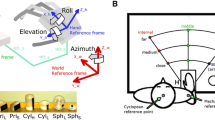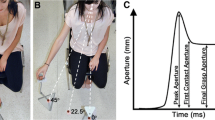Abstract
During reaching to grasp objects with different shapes hand posture is molded gradually to the object's contours. The present study examined the extent to which the temporal evolution of hand posture depends on continuous visual feedback. We asked subjects to reach and grasp objects with different shapes under five vision conditions (VCs). Subjects wore liquid crystal spectacles that occluded vision at four different latencies from onset of the reach. As a control, full-vision trials (VC5) were interspersed among the blocked vision trials. Object shapes and all VCs were presented to the subjects in random order. Hand posture was measured by 15 sensors embedded in a glove. Linear regression analysis, discriminant analysis, and information theory were used to assess the effect of removing vision on the temporal evolution of hand shape. We found that reach duration increased when vision was occluded early in the reach. This was caused primarily by a slower approach of the hand toward the object near the end of the reach. However, vision condition did not have a significant effect on the covariation patterns of joint rotations, indicating that the gradual evolution of hand posture occurs in a similar fashion regardless of vision. Discriminant analysis further supported this interpretation, as the extent to which hand posture resembled object shape and the rate at which hand posture discrimination occurred throughout the movement were similar across vision conditions. These results extend previous observations on memory-guided reaches by showing that continuous visual feedback of the hand and/or object is not necessary to allow the hand to gradually conform to object contours.








Similar content being viewed by others
References
Berthier NE, Clifton RK, Gullapalli V, McCall DD, Robin DJ (1996) Visual information and object size in the control of reaching. J Mot Behav 28:187–197
Chieffi S, Gentilucci M (1993) Coordination between the transport and the grasp components during prehension movements. Exp Brain Res 94:471–477
Churchill A, Hopkins B, Ronnqvist L, Vogt S (2000) Vision of the hand and environmental context of human prehension. Exp Brain Res 134:81–89
Connolly JD, Goodale MA (1999) The role of visual feedback of hand position in the control of manual prehension. Exp Brain Res 125:281–286
Elliot D, Allard F (1985) The utilization of visual feedback information during rapid pointing movements. Q J Exp Psychol A 37:407–425
Gentilucci M, Toni I, Chieffi S, Pavesi G (1994) The role of proprioception in the control of prehension movements: a kinematic study in a peripherally deafferented patient and in normal subjects. Exp Brain Res 99:483–500
Jakobson LS, Goodale MA (1991) Factors affecting higher-order movement planning: a kinematic analysis of human prehension. Exp Brain Res 86:199–208
Jeannerod M (1981) Intersegmental coordination during reaching at natural visual objects. In: Long J, Baddeley A (eds) Attention and performance IX. Erlbaum, Hillsdale, pp153–168
Jeannerod M (1984) The timing of natural prehension movements. J Mot Behav 16:235–254
Jeannerod M (1986) The formation of finger grip during prehension. A cortically mediated visuomotor pattern. Behav Brain Res 19:99–116
Jeannerod M (1999) Visuomotor channels: their integration in goal-directed prehension. Hum Mov Sci 18:201–218
Johansson RS, Westling G, Bäckström A, Flanagan JR (2001) Eye-hand coordination in object manipulation. J Neurosci 21:6917–6932
Johnson KO, Phillips JR (1981) Tactile spatial resolution. I. Two-point discrimination, gap detection, grating recognition. J Neurophysiol 46:1177–1191
Johnson RA, Wichern DW (1992) Applied multivariate statistical analysis. Prentice Hall, Englewood Cliffs
Marteniuk RG, MacKenzie CL, Athenes S (1990) Functional relationships between grasp and transport components in a prehension task. Hum Mov Sci 9:149–176
Mason CR, Gomez JE, Ebner, TJ (2001) Hand synergies during reach-to-grasp. J Neurophysiol 86:2896–2910
Milgram P (1987) A spectacle-mounted liquid-crystal tachistoscope. Behav Res Methods Instrum Comput 19:449–456
Sakitt B (1980) Visual-motor efficiency (VME) and the information transmitted in visual-motor tasks. Bull Psychol Soc 16:329–332
Santello M (2002) Kinematic synergies for the control of hand shape. Arch Ital Biol 140:221–228
Santello M, Soechting JF (1997) Matching object size by controlling finger span and hand shape. Somatosens Mot Res 14:203–212
Santello M, Soechting JF (1998) Gradual molding of the hand to object contours. J Neurophysiol 79:1307–1320
Santello M, Flanders M, Soechting JF (1998) Postural synergies for tool use. J Neurosci 18:10105–10115
Santello M, Flanders M, Soechting, JF (2002) Patterns of hand motion and the influence of sensory guidance. J Neurosci 22:1426–1435
Schettino LF, Adamovich, SV, Poizner H (2000) Effects of object shape and visual feedback on hand configuration during grasping. Soc Neurosci Abstr 26:179
Schettino LF, Adamovich SV, Gordon AM, Poizner H (2001) The role of the transport phase during grasping tactilely-defined target shapes. Soc Neurosci Abstr 27:792
Shannon CE (1948) The mathematical theory of communication. Bell Syst Technol J 27:379–423
Zelaznik HN, Hawkins B, Kisselburgh L (1983) Rapid visual feedback processing in single-aiming movements. J Mot Behav 15:217–236
Acknowledgements
We thank Dr. John F. Soechting for his helpful comments on an earlier version of this manuscript.
Author information
Authors and Affiliations
Corresponding author
Rights and permissions
About this article
Cite this article
Winges, S.A., Weber, D.J. & Santello, M. The role of vision on hand preshaping during reach to grasp. Exp Brain Res 152, 489–498 (2003). https://doi.org/10.1007/s00221-003-1571-9
Received:
Accepted:
Published:
Issue Date:
DOI: https://doi.org/10.1007/s00221-003-1571-9




